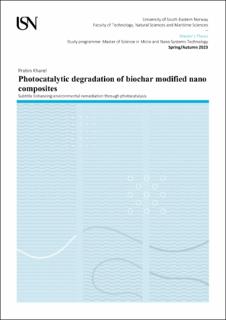| dc.description.abstract | Contamination of surface water and groundwater from industrial discharges is a persistent environmental issue. In recent years, the development of solar photochemical approaches utilizing catalysts such as TiO2, ZnO, and their composites has shown promising for oxidative degradation processes. In this study, we investigated the use of TiO2, ZnO, and biochar composite catalysts for the photocatalytic degradation of methyl orange in wastewater. The catalysts were prepared using the autoclave method and characterized using XRD, SEM-EDS, FTIR, and UV-Vis spectrophotometry. The study also utilized a tungsten halogen light source (260 nm–2500 nm, 600 W) as one of the irradiation sources, which highlights the practicality of this approach. Our results showed that the addition of biochar to the catalysts enhanced their photocatalytic activity, with the TiO2/biochar and ZnO/biochar composites displaying the highest efficiency, achieving a decolorization efficiency of up to 90%. The degradation process followed pseudo-first-order kinetics, with high r2 values indicating a good fit. Our characterization results indicated that large surface area of biochar provides a higher contact area between the catalysts and pollutants, leading to more efficient adsorption and degradation. The utilization of TiO2, ZnO, and biochar composite catalysts offers a practical solution for the efficient, cost-effective, and sustainable treatment of wastewater. Our study demonstrates the potential of these catalysts to remove various pollutants from wastewater, providing a constructive and eco-friendly perspective to water treatment. Lastly, this approach presents a sustainable and practical mitigation for the treatment of polluted water sources, offering benefits such as high efficiency and low environmental impact. Future studies can build upon these findings to develop more productive methods for water treatm | |
